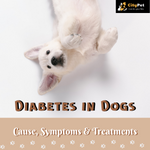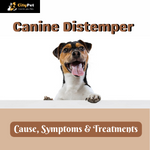Cushing Syndrome in Pets: Causes, Symptoms & Treatments
Cushing’s Syndrome, also known as hyperadrenocorticism, is a condition that can affect pets, especially dogs. It occurs when the body produces an excessive amount of the hormone cortisol.
Cortisol is a hormone that helps the body respond to stress, regulates blood sugar levels, and controls inflammation. However, when the body produces too much cortisol, it can lead to a variety of health problems.
Cushing’s Syndrome can be caused by a variety of factors, including a tumor in the pituitary gland or adrenal gland, or prolonged use of steroids.
If you suspect that your pet has Cushing’s Syndrome, it is important to take them to a veterinarian for an accurate diagnosis and treatment plan. Treatment may include medication, surgery, or other forms of therapy depending on the underlying cause of the condition.
Causes of Cushing Syndrome in Pets
Cushing’s Syndrome in pets is primarily caused by the overproduction of the hormone cortisol, which can be caused by several underlying factors, including:
- Pituitary-dependent hyperadrenocorticism: This is the most common cause of Cushing’s Syndrome in dogs and occurs when a tumor in the pituitary gland causes an overproduction of the hormone ACTH, which stimulates the adrenal glands to produce excessive amounts of cortisol.
- Adrenal-dependent hyperadrenocorticism: This occurs when a tumor in one or both of the adrenal glands causes an overproduction of cortisol.
- Iatrogenic Cushing’s Syndrome: This is caused by prolonged administration of corticosteroid medications, which are often used to treat inflammatory or autoimmune conditions.
- Ectopic ACTH syndrome: This is a rare form of Cushing’s Syndrome caused by a tumor that produces ACTH outside of the pituitary gland.
- Familial or genetic predisposition: Certain breeds, such as Poodles, Dachshunds, Boxers, and Beagles, may be more susceptible to developing Cushing’s Syndrome.
It’s important to note that some of these causes are more common in dogs than cats, and the clinical signs and symptoms of Cushing’s Syndrome may vary depending on the underlying cause. A veterinarian can perform diagnostic tests to determine the cause of the condition and recommend appropriate treatment options.
Symptoms of Cushing Syndrome in Pets
The symptoms of Cushing’s Syndrome in pets can vary depending on the underlying cause and the severity of the condition. However, some common symptoms of Cushing’s Syndrome in pets include:
- Increased thirst and urination: Pets with Cushing’s Syndrome may drink and urinate more frequently than normal.
- Increased appetite: Pets with Cushing’s Syndrome may have an increased appetite and may beg for food more often.
- Weight gain: Pets with Cushing’s Syndrome may gain weight, especially in their abdomen and chest area.
- Hair loss: Pets with Cushing’s Syndrome may experience hair loss, especially on their flanks, tail, and back legs.
- Pot-bellied appearance: Pets with Cushing’s Syndrome may develop a rounded, pot-bellied appearance due to an accumulation of fat in the abdominal area.
- Thin skin: Pets with Cushing’s Syndrome may have thin, fragile skin that bruises easily.
- Muscle weakness: Pets with Cushing’s Syndrome may have decreased muscle mass and may be less active than usual.
- Panting: Pets with Cushing’s Syndrome may pant excessively, especially when they are not exerting themselves.
- Skin infections: Pets with Cushing’s Syndrome may be prone to skin infections, which can cause itching and discomfort.
If you notice any of these symptoms in your pet, it’s important to take them to a veterinarian for an evaluation. A veterinarian can perform diagnostic tests to determine if your pet has Cushing’s Syndrome and recommend appropriate treatment options.
Diagnose of Cushing Syndrome
The diagnosis of Cushing’s Syndrome in pets can involve a combination of diagnostic tests and examinations. Here are some common diagnostic methods used by veterinarians:
- Physical examination: The veterinarian will perform a thorough physical examination of the pet, looking for any signs of Cushing’s Syndrome such as hair loss, thin skin, a pot-bellied appearance, or muscle weakness.
- Blood tests: Blood tests can help evaluate the levels of cortisol in the pet’s blood. Different blood tests can help differentiate between the different forms of Cushing’s Syndrome.
- Urine tests: Urine tests can also help evaluate the levels of cortisol in the pet’s urine, which can provide additional information to support a diagnosis.
- ACTH stimulation test: This test involves measuring the pet’s cortisol levels before and after the administration of synthetic ACTH, which can help determine if the pet’s adrenal glands are producing excessive amounts of cortisol.
- Low-dose dexamethasone suppression test: This test involves administering a low dose of dexamethasone, which is a synthetic steroid. The pet’s cortisol levels are measured before and after the administration of dexamethasone to determine if the pet’s adrenal glands are producing excessive amounts of cortisol.
- Imaging tests: X-rays, ultrasounds, or CT scans can help identify any tumors or abnormalities in the pet’s adrenal glands or other organs.
- Endocrine testing: This involves measuring the levels of different hormones involved in the regulation of cortisol production. This testing can help identify the specific cause of Cushing’s Syndrome in the pet.
If you suspect that your pet has Cushing’s Syndrome, it’s important to take them to a veterinarian for a proper diagnosis. A veterinarian can recommend appropriate testing and help develop a treatment plan to manage the pet’s condition.
Treatments for Cushing Syndrome
The treatment of Cushing’s Syndrome in pets will depend on the underlying cause of the condition. Here are some common treatment options:
- Medications: Medications can be used to manage the symptoms of Cushing’s Syndrome, especially if the underlying cause cannot be addressed. This may involve the use of drugs such as trilostane, which inhibits cortisol production.
- Surgery: If the underlying cause of Cushing’s Syndrome is a tumor in the adrenal gland or pituitary gland, surgical removal may be recommended. This is often the most effective treatment for adrenal-dependent Cushing’s Syndrome.
- Radiation therapy: If a tumor cannot be surgically removed, radiation therapy may be used to shrink the tumor and reduce the pet’s cortisol levels.
- Dietary changes: Changing the pet’s diet can help manage its weight and reduce the risk of obesity, which is a common symptom of Cushing’s Syndrome.
- Monitoring: Once a pet has been diagnosed with Cushing’s Syndrome, it will need to be monitored regularly to ensure that its cortisol levels are within a healthy range. This may involve regular blood tests and follow-up appointments with a veterinarian.
It’s important to note that the treatment of Cushing’s Syndrome can be complex and may require ongoing management. A veterinarian can recommend appropriate treatment options based on the underlying cause of the pet’s condition and their overall health status. With proper treatment and management, many pets with Cushing’s Syndrome can live happy, healthy lives.
If you have trouble understanding Cushing Syndrome in Pets, you can always contact us, as City Pet Hospital has expert vets who are specialized in many diseases related to pets.



























